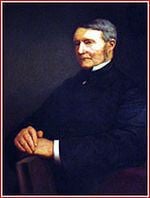Residence England Name John Hymers | Fields Mathematician Nationality British | |
 | ||
Education St John's College, Cambridge Books A Treatise on the Theory of Algebraical Equations, A Treatise on the Theory of Algebraical Equations by J. Hymers Similar People James Joseph Sylvester, John Couch Adams, Augustus De Morgan | ||
Why John Hymers Chose La Salle
John Hymers (1803–1887) was an English mathematician and cleric.
Contents

Life
Hymers was born 20 July 1803 at Ormesby in Cleveland, Yorkshire; his father was a farmer, and his mother was daughter of John Parrington, rector of Skelton in Cleveland. After attending school at Witton-le-Wear, Durham, and Sedbergh School, he gained a sizarship at St John's College, Cambridge, in 1822. Graduating B.A. in 1826 as second wrangler, he was elected fellow in 1827.
Hymers was for some years successful with private pupils, and became assistant tutor of his college in 1829, tutor in 1832, senior fellow in 1838, president in 1848. He was moderator in the mathematical tripos 1833-4, and Lady Margaret preacher in 1841. He proceeded B.D. in 1836, and D.D. in 1841, and was elected Fellow of the Royal Society 31 May 1838.
Hymers never married. In 1852 he was presented by his college to the rectory of Brandesburton in Holderness, East Yorkshire, and spent there the last 35 years of his life. He was appointed J.P. for the East Riding in 1857, and enjoyed good health until his death on 7 April 1887.
Legacy
By his will of 24 August 1885 Hymers bequeathed all his property to the mayor and corporation of Kingston upon Hull as a foundation for a grammar school "to train intelligence in whatever rank it may be found amongst the population of the town and port". An obscurity in the wording of the will rendered the bequest invalid, but the heir-at-law spontaneously offered the corporation a sum of £40,000 to fulfil Hymers's purpose.
Hymers had a portrait of William Wordsworth, to whom he was distantly related, painted by Henry William Pickersgill for his college. He later presented to its library some of the poet's manuscripts, including a sonnet addressed to the picture.
Works
Hymers's books, with one exception, were mathematical, and were influenced by the mathematics of continental Europe. The major ones were:
Hymers issued a revised edition of Watkin Maddy's Treatise on Astronomy. He also reprinted John Fisher's funeral sermon on Margaret Beaufort, Countess of Richmond and Derby, with notes to illustrate "her munificent patronage of religion and learning", and published catalogues of the Margaret professors and preachers at Cambridge and Oxford.
